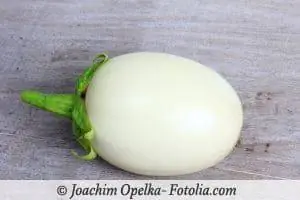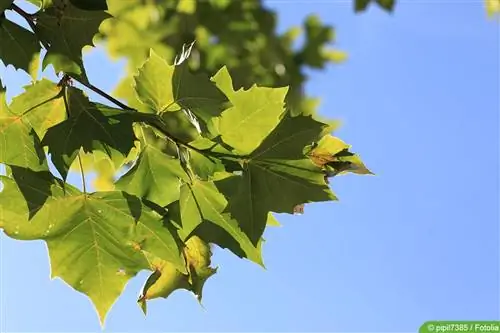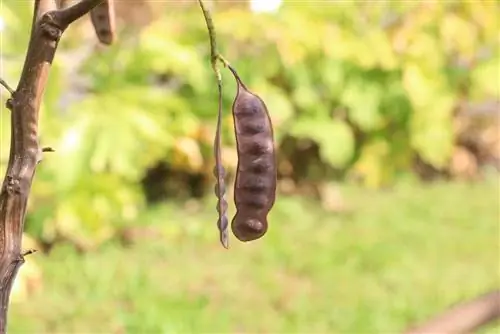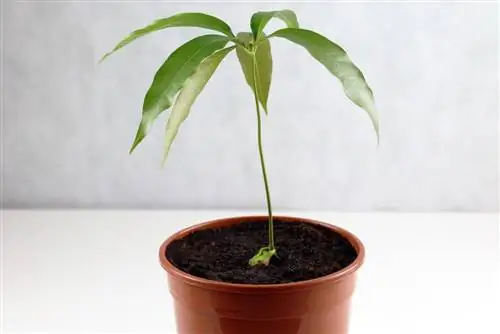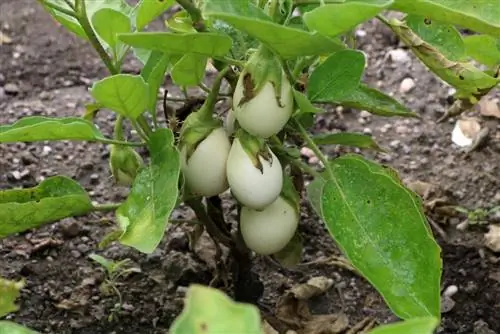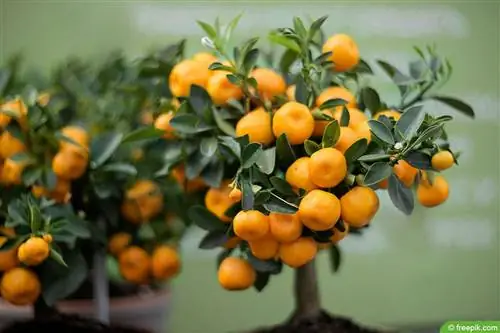- Author admin [email protected].
- Public 2023-12-17 03:39.
- Last modified 2025-01-24 12:45.
The egg tree plant Solanum melongena is a rare and at the same time somewhat bizarre houseplant. The fruits of this plant, which form between August and October, are edible but have primarily an ornamental value. Like eggplant and tomatoes, it belongs to the Solanaceae family. As a rule, it grows as an annual and reaches heights of around 50 cm. It simultaneously bears violet-colored flowers and fruits that grow to 3-5 cm in size and take on a bright yellow color when ripe.
Plant in the garden or in a container
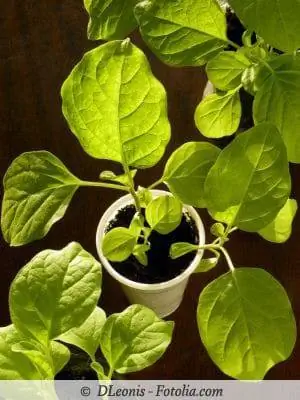
Planted out in the garden, this plant is an annual. If cultivated in a bucket and kept frost-free over the winter, it can also be kept for several years. When planting in the garden, the planting area should be cleared of weeds, roots and stones. Enriching the soil with compost or horn shavings is an optimal starting fertilizer for the egg tree plant. Depending on the nature of the soil, drainage made of gravel or perlite ensures good water drainage. For potted plants, make sure you have a sufficiently large planter and sufficient drainage. Then you should just put them in a warm and protected place and don't forget to water them.
Location and soil
The egg tree plant, which is part of the nightshade family, should always be kept warm and bright, preferably sunny. The room temperature should be at least 20 °C. During the summer it can easily be left outdoors, ideally in front of a heat-retaining house wall. In locations that are too cool and dark, this plant grows more poorly and does not produce flowers and therefore no fruit. As far as the condition of the soil is concerned, it should be nutrient-rich, humus-rich, evenly moist and permeable, ideally with a proportion of sand. Standard standard earth, for example, is well suited.
Tip:
This plant should only be put outside when it is warm enough, otherwise it could be damaged.
Watering and fertilizing
- Solanum melongena is a relatively fast-growing plant.
- Your water requirement is increased during the growth and flowering phase.
- The soil or substrate should never dry out.
- When it is dry, the egg tree plant quickly drops its leaves.
- Then it should be watered thoroughly, after which it will recover quickly.
- Otherwise water regularly or depending on the weather.
- Allow the top layer of soil to dry slightly before each watering.
- In order to cover the nutrient requirements, fertilization should be carried out weekly during growth.
- Commercial pot plant fertilizers or liquid fertilizers are suitable for this.
Tip:
The egg tree plant is self-pollinating. In order for the flowers to be pollinated at all, the plant must be shaken frequently during flowering.
Wintering
Usually this plant is an annual, especially specimens planted in the garden. Potted plants, on the other hand, can overwinter in a frost-free area or in indoor cultivation and, with a bit of luck, sprout again in spring. However, in winter you should ensure there is sufficient light and temperatures between 10 and 17 °C and you should not fertilize. If overwintering is too time-consuming for you, you can purchase young plants from gardening stores or sow them again every year, although this is not always successful. The seeds can be obtained from the ripe fruits in autumn, for example.
Tip:
Especially in winter, when the air in the room is warm and dry, this plant should be checked regularly for pest infestation.
Creation & Propagation
It is better to sow this decorative plant on the windowsill from January to October, but it is possible in a greenhouse. To support germination and eliminate germination inhibition, the seeds should be soaked in lukewarm water for about 24 hours before sowing. They are then placed approx. 0.5-1.0 cm deep in potting soil and moistened. Coconut fiber is particularly suitable for this, it is low in nutrients and, above all, permeable to air. Until germination, the substrate should be kept evenly moist but not wet. To ensure optimal humidity, cover the sowing container with translucent foil or glass and place it in a bright place without direct sunlight.
At a germination temperature between 20 and 25 °C, it takes around 14-20 days for germination. Around 5-8 weeks after germination, the seedlings are usually large and strong enough to be separated. If there are several plants, a planting distance of approx. 40 cm is recommended. When separating, you should be particularly careful so as not to damage the sensitive roots and make it easier for the plants to grow. As soon as it is warm enough outside, but definitely not before the Ice Saints, the young plants can move outside. It is best not to be exposed to direct sun for the first few weeks outdoors to avoid burns.
Tip:
Depending on root growth, it may need to be repotted into a larger planter from time to time. To prevent the seeds or substrate from becoming moldy or rotting, the respective cover should be removed briefly at regular intervals.
Diseases and pests
Fall of flowers
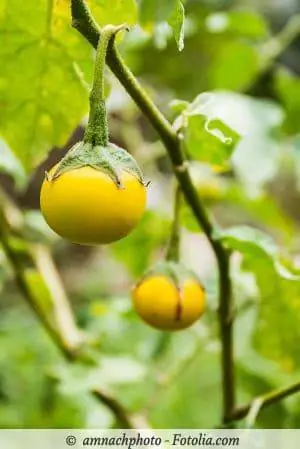
If the egg tree plant is kept in a glass or greenhouse, it may drop its flowers if there is insufficient ventilation and prolonged high temperatures of over 35 °C. To counteract this, the greenhouse should be ventilated as regularly as possible and shaded if necessary.
Gray horse
An infestation by gray mold is reflected in a dusty, gray coating on the leaves. It mainly occurs in unfavorable locations and when there is insufficient humidity. If the infestation is mild, all affected plant parts are removed and disposed of accordingly. Chemical control agents should be avoided if possible, especially if the fruits are intended for consumption and the plant is grown indoors. If chemical control is unavoidable, it should only be carried out in damp weather, between the start of flowering and shortly before harvest, and repeated at appropriate intervals. If the infestation is advanced, it may make sense to dispose of the entire plant, especially with gray mold. The best way to prevent this fungal disease is through optimal cultural measures, i.e. the right location and the right amount of watering and fertilizing.
Tip:
When using chemical agents, the instructions of the respective manufacturer should be strictly followed - especially for plants that bear edible fruits such as the egg tree plant.
Spider mites
A spider mite infestation can be recognized by the typical white webs on the leaf axils. If you spray the plants with a fine mist, you can see them very well. Infestation of this plant usually occurs during overwintering due to low humidity or in the greenhouse in summer. Predatory mites, among other things, can be used to combat this. If the fruits of the plant are only intended as an ornament, they can also be treated with systemic agents.
Tip:
If the egg tree plant is planted or placed in close proximity to fragrant herbs such as thyme, basil or lavender, these can help to avoid pest infestation.
Conclusion of the editors
The egg tree plant Solanum melongena is a very decorative and sometimes bizarre plant that is often confused with eggplant, although they are two different plants. It can easily be planted out in the garden for an annual crop. If you want it to overwinter, cultivating it in a bucket makes sense. Ideal location conditions should be ensured both indoors and outdoors, which can also counteract pest infestation.
What you should know about the egg tree plant in brief
Care
- Egg tree plants are easy to grow from seeds.
- Germination usually occurs after two weeks in well-moist potting soil and a warm location.
- A foil or glass pane on the pot prevents the soil from drying out significantly.
- To prevent mold from forming, you have to ventilate occasionally.
- Six weeks later, the young plants are large enough so that they can be transplanted into pots.
- The young roots must not be damaged, the plants react very sensitively to this.
- Only when the temperatures are mild enough are egg tree plants allowed outdoors.
- The optimal care of Solanum melongena includes the administration of pot plant fertilizer in May and June.
- Egg tree plants are self-pollinators.

Stand
- Solanum melongena needs a sunny location in order to develop splendidly.
- Warmth is a basic need for this plant. The soil should be nutrient-rich and never dry out completely.
- When there is a lack of water, the plant quickly lets its elongated leaves droop.
- The ideal place for pots containing egg tree plants would be in front of a white painted wall that reflects the sun's rays.
Harvest
- The initially white fruits later change their color to a yellowish shade as they ripen.
- Only then are the eggs ripe and the egg tree plant harvest can begin. The fruits can be stored for a long time.
- Similar to eggplant, the fruits can be baked or made into salad.
- Egg tree plants only grow as annuals, which is why seeds must be saved before growing again.

